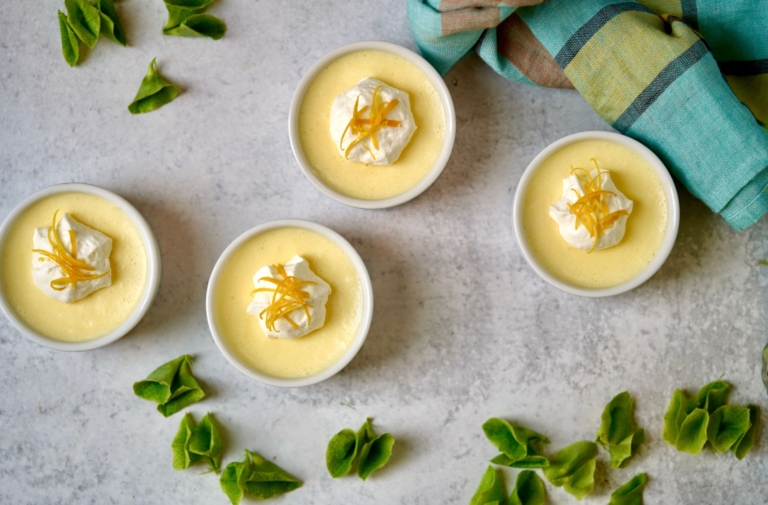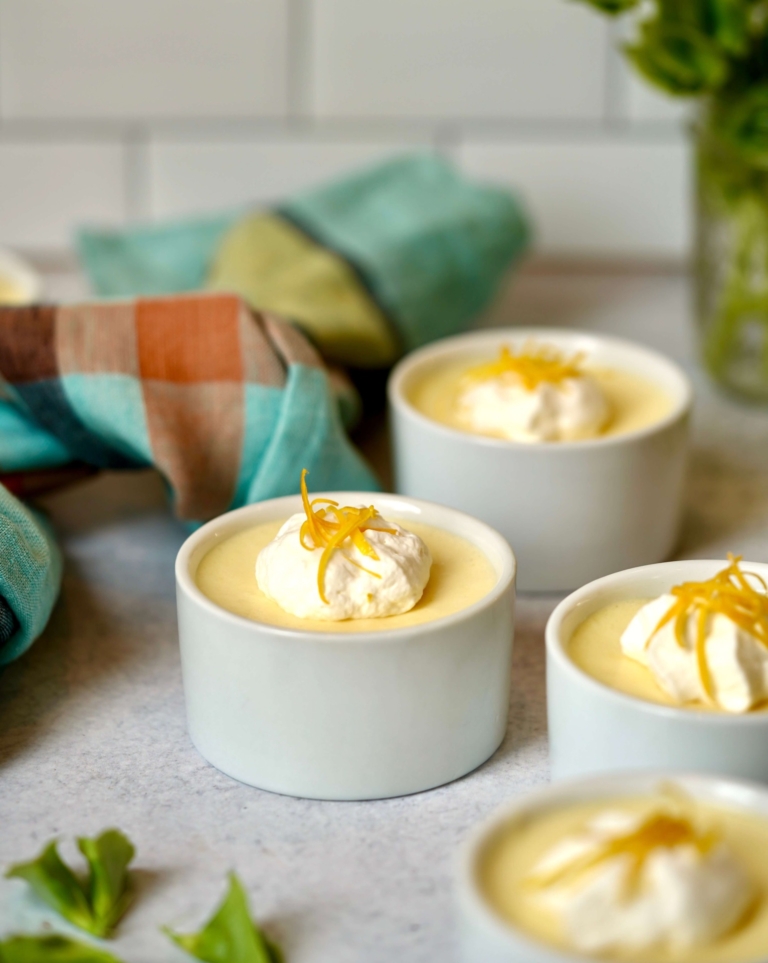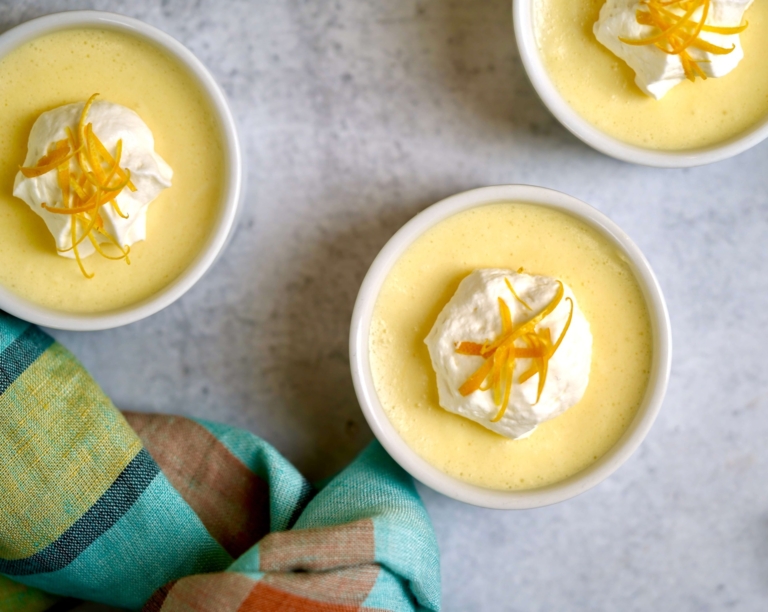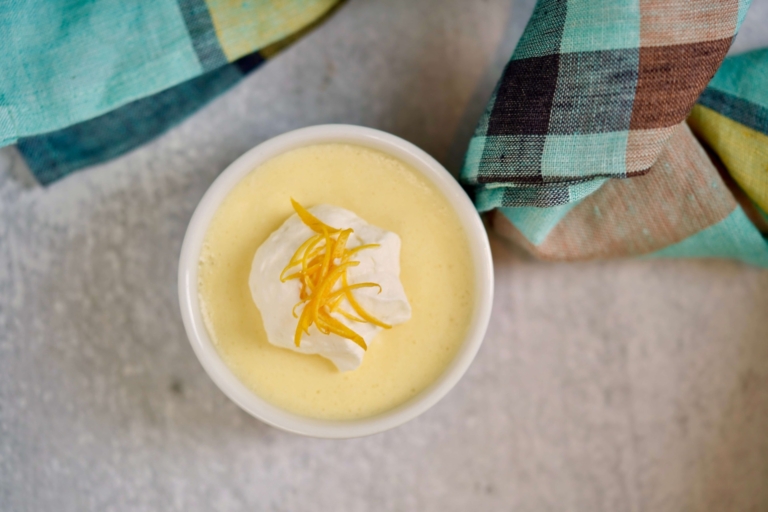Lemon Mousse

Lemon mousse is a fresh and easy dessert that combines the tangy flavor of lemon with a light, airy texture that’s incredibly pleasing. This, my friends, is the perfect, prep-ahead dessert for springtime. By definition, a mousse is a soft, sweet or savory, prepared food that incorporates air bubbles to create its distinct silky mouth feel that’s so memorable. But a mousse can actually be light and fluffy or thick and creamy, simply depending on the method of preparation. Food historians believe that mousse likely originated in France during the early 18th century. In French, “mousse“, pronounced “moose“, translates to “foam” or “froth“, (a mass of small bubbles), and is perhaps a direct nod to the technique of mousse making itself.

Sweet + Savory Mousse
Because a mousse can be sweet or savory it is a much more versatile dish than many realize. A sweet mousse, the more common of the two, is typically made with whipped egg whites, whipped cream, or a combination of both, with added flavorings such as; chocolate, coffee, caramel, fruits, herbs, and spices. Typically, a mousse is served cold which gives it a slightly denser texture. But at times, a dessert mousse can also be frozen, which is another way I love to enjoy them. Although a sweet mousse is typically served as a dessert, it can also be used as a filling in cakes. In contrast, a savory mousse can be made from meat, fish, shellfish, foie gras, (my favorite) cheese, or even vegetables and can be served either warm, cold or at room temperature.

Pudding, Mousse And Custard
The world of puddings, mousses, and custards is a bit confusing and you would not be the first person if you didn’t know the difference between them. Because of their many similarities, each of these foods is frequently confused with one another, so let’s break down the differences between them. All three of these, when in dessert form, start with a base of milk and sugar. What’s added in is what accounts for the different consistency and textures of the final products.
Pudding:
- Pudding is a broad term that encompasses various types of desserts, both sweet and savory, across different cultures. In some regions, pudding refers specifically to a sweet, creamy dessert typically thickened with starch (such as cornstarch or flour) or gelatin.
- Puddings can be served hot or cold and may come in a variety of flavors, including chocolate, vanilla, butterscotch, and more.
- Texture-wise, puddings are usually smooth and creamy, with a consistency that can range from thick and dense to lighter and more gelatinous, depending on the ingredients and preparation method.
Mousse:
- Mousse is a light and airy dessert made by folding whipped cream or egg whites into a base mixture, typically consisting of melted chocolate, fruit puree, or other flavorings.
- The key characteristic of mousse is its fluffy and creamy texture, which is achieved by incorporating air into the mixture.
- Unlike pudding or custard, mousse may contain, but does not require, cooking or thickening agents like starch or eggs.
- Mousse desserts are often chilled before serving to set their texture and enhance their flavor.
Custard:
- Custard is a creamy dessert made by combining milk or cream with eggs, sugar, and flavorings such as vanilla.
- The mixture is typically cooked gently on the stovetop or baked in the oven until it thickens and sets, forming a smooth and silky texture.
- Custards can vary in thickness, with some being more pourable while others are firmer and sliceable.
- Unlike puddings, custards rely on eggs as the primary thickening agent, giving them a richer and more luxurious texture.
- Custards can be served warm or chilled, depending on the recipe and personal preference.
Lemon mousse is a beautifully balanced thing. It is airy, yet rich and sure to please just about anyone with a sweet tooth. This effortless dessert is also great for those who like to dabble in desserts but don’t have hours to invest. This lovely lemon mousse is elegant enough to be served whenever you want to impress your guests with a light and flavorful holiday dessert. Yet, truthfully, it’s also simple enough to whip up for a Sunday night meal with the immediate family.

Lemon Mousse
Ingredients:
- 6 large eggs
- 1 cup + 2 tablespoons sugar, divided
- Zest of 1 lemon
- 1/2 cup freshly squeezed lemon juice
- Dash of salt
- 1 cup heavy whipping cream, divided
- 2 tablespoons Confectioners' sugar
- Finely grated lemon zest or candied lemon zest, for garnish (optional)
Directions:
- In a large heat-proof bowl, whisk together 3 whole eggs, 3 egg yolks (reserve the whites in a separate bowl for later), 1 cup of sugar, lemon zest, lemon juice, and salt. Set aside.
- Fill a large stockpot with a few inches of water and bring to boiling. Reduce to a simmer.
- Place the bowl of ingredients over the pot of simmering water (creating a double boiler) and cook, stirring constantly, with a rubber spatula until mixture thicken, about 15 minutes and a digital instant-read thermometer temperature reaches 150 degree F.
- Remove bowl from heat and set aside to cool slightly. Once the mixture has cooled a little, place a piece of plastic wrap directly on the surface of the mixture and refrigerate for at least 2 hours, or until completely chilled.
- Once the lemon mixture has cooled, place the 3 remaining egg whites into the bowl of a kitchen mixer, such as a KitchenAid, fitted with the whisk attachment, and beat on high speed, for 1 minute. Add the remaining 2 tablespoons of sugar and continue to beat the egg whites until stiff peaks form.
- Using a rubber spatula, gently fold the egg whites into the cooled lemon mixture being very careful not to over mix which will deflate the egg whites. Set aside.
- Add 1/2 a cup of the heavy cream to the bowl you used for the egg whites, and beat on high speed until stiff peaks form.
- Using a rubber spatula, gently fold in the unsweetened whipped cream into the lemon mixture, once again, do not over mix.
- Spoon the lemon mousse into individual ramekins, level the top and refrigerate for at least 30 minutes.
- To Serve: Place the remaining 1/2 cup of heavy cream in the cleaned bowl of the kitchen mixer, fitted with the whisk attachment, and beat on high until soft peaks form. Add the confectioners' sugar and continue to beat until stiff peaks have formed.
- Top with lemon mousse with a dollop of the sweetened whipped cream and additional lemon zest, if using.



How long will it keep in the refrigerator.
I always like to air on caution, the mousse should be fine well wrapped, and refrigerated for up to 3 days.
Can I simply put the Mousse into a soufflé dish instead of the ramekins (I’m traveling with it)?
Hi Janice. Thanks for reaching out. Yes, you can absolutely put this in a single dish if you prefer. I hope you enjoy it.